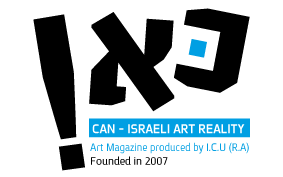
| Home Page | Editor Notices | Museums | Galleries | Publication | Donation | Contact Us |


 | |||||||||||||||
| |||||||||||||||


| |||||||||||||||
| An Essay on Life / Hana Barak Engel in Hananko Museum in Kiev |
And at night, in the dwindling light of a red sunset, He was tired of waging a world war. So the man laid down his crumbling body, Lying still on the soil of nations. And he dreamt of an angel flying by on his wings, Giving him a ride to the beach. Nathan Alterman, The Seventh Column, Book 1, Am Oved Publishing, p. 7 Hana Barak Engel's body of work is characterized by human forms, both male and female, against a background of color and geometric patterns that regulate the movement of those human figures. Engel began her journey in the art world as a sculptor. Three dimensional sculpting allows the creation of motion that seems like 3D, but will always remain clear as a human shape. Now, as the artist is immerses herself in painting, this transition from the three dimensional to a two dimensional medium produces a kind of intentional distortion that serves its purpose in transforming her figures into something that is not bound by the laws of reality. The characters are almost schematically drawn, with universal facial features, both in profile and full frontal. Eyes, eyebrows, nose, mouth and ears are like identifying markers for the viewer to understand that this is a human being posed on canvas. The figures are monochromatic, using small shadings that give a sense of depth and are placed on a monochromatic surface devoid of any place marks, an unidentifiable space. The verse "So the man laid down his crumbling body / Lying still on the soil of nations," defines in poetic words what is visible to the viewer looking at this art work hanging on the wall of a studio, a gallery or a museum. Hana Barak Engel’s life story is similar to that of many Israelis. She immigrated to Israel at a tender age, and despite the hardships of everyday life, she found herself engaged in art that she referred to as a valve through which she could free herself from financial struggles. Her affinity for mysticism, for ancient cultures, for mythology, led her to create a whole, private world of her own. The various mythologies have been passed on to us over millennia in the form of words and imagery that became inalienable assets of humanity. One work that caught my attention is that of a bull, with his head tilted as he prepares to gore, or is he just exhausted? This half bull, half human is a familiar image from Greek mythology. For Hana, the Minotaur's conflict is in essence the same conflict she finds herself in, juggling between her life as an artist in search of new themes, and her everyday life. The bull is a blue patch of color on a yellow background, with parts of his human body engraved alongside his bull’s head. In another series, a group of women is portrayed. They are also schematically described, with no defined facial expressions, but with human anthropomorphic attributes, painted on a monochromatic background which magnifies their presence in the painting. But the work that attracted my attention the most is a painting in which three figures, in three different positions, are painted on monochromatic rhombi (or diamond shapes), with two figures in a plausible human pose, while the third is seemingly falling from heaven. Unlike the other two figures, this one is painted against a bright background that intensifies her impossible pose, and shows most clearly her sudden appearance from a place unknown. It is neither the color of the sky, nor the color of earth; it is a red color emanating from a mystical place, spewing the figure in our direction. For if this is the so called omnipotent human being, His character inflexible, indelible. Is it not a bit of shame that this big big world Fell into his small hands? Nathan Alterman, The Seventh Column, Book A, Am Oved Publishing, p. 186 The connection I made with Alterman's verses in "The Seventh Column" is not accidental. The subheading of Alterman's book is "Songs of our times and current affairs". The works of Hana Barak Engel fit well with this subheading. Alterman regularly published his verses in the daily newspaper Davar, yet his poems were also kind of an op-ed on current affairs. In her art, Engel writes her own op-eds on any given situation. She deals not only with aesthetics, but with the content of things that she experiences, both externally and internally. Her moods, her thoughts, her opinions are all manifest on the canvas in a way that allows the viewers to look at the work on the one hand, yet on the other, also obliges them to read and not just look, for that is the hallmark of good art. In her intelligent way, Hana Barak Engel, does not fall into the trap of mannerisms, but expresses her opinions in a way that enables the viewers to anchor themselves to her writings by means of familiar signs, the human body, the body of the animal, archetypal features and color. All in all, her work is an essay on life. Meir Aharonson, Winter 2017 Read more  |
| all rights reserved - CAN ISRAELI ART REALITY |
| סייבורג מחשבים - בניית אתרים |